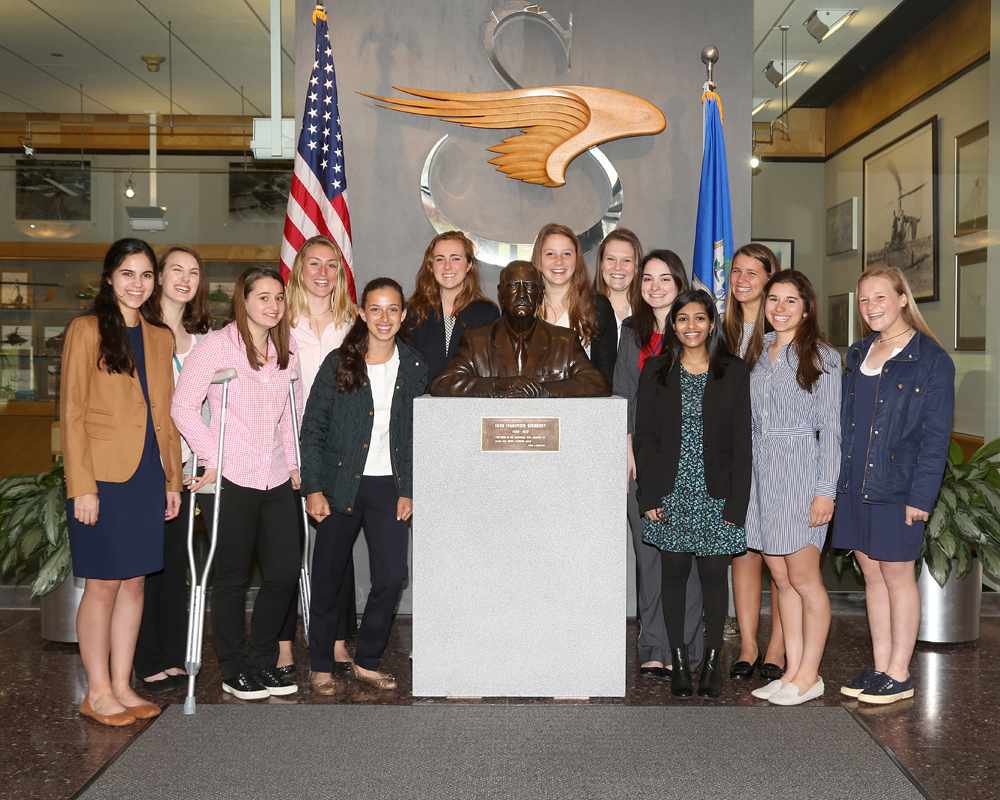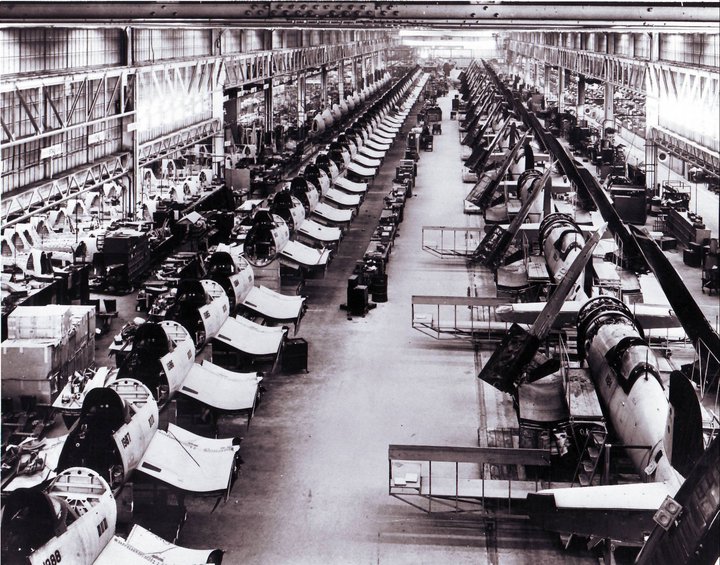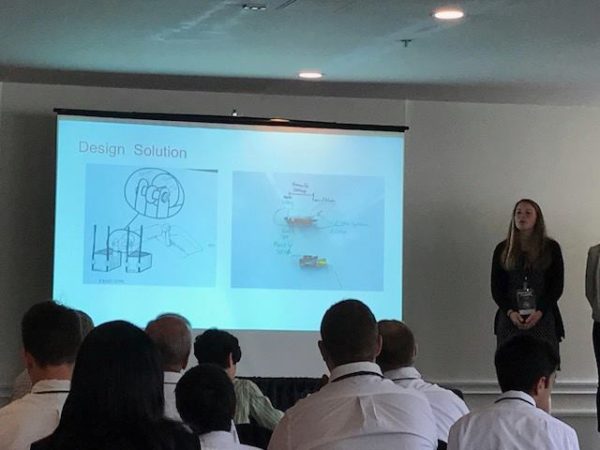Sikorsky ‘STEM’ Challenge: Design Fix Repair For Corsair Aileron Linkage
“At that time [1909] the chief engineer was almost always the chief test pilot as well. That had the fortunate result of eliminating poor engineering early in aviation.” – Igor Sikorsky
(MILFORD, CT) – July 11, 2017 – Lauralton Hall’s engineering team, “The Wright Sisters,” rose to the challenge and won the annual Sikorsky STEM Challenge. Lauralton Hall was the only all-girls school of the eight Connecticut high schools chosen to participate in this yearlong competition to design a repair connection for a broken aileron linkage on an F4U-4 Corsair.

Lauralton Hall’s engineering team, The Wright Sisters, was chosen as the winner of the annual Sikorsky STEM competition, a year-long design challenge was to solve a real-life engineering problem for the F4U4-Corsair. Representing the team (left to right): Kristin Franco, Grace Jensen, Isabella Secchiaroli, Madelyn Monahan, Juliana Gonzalez, Michaela O’Donnell, Leah Cogguillo, Rory Woods, Olivia D’Andrea, Yashaswini Soleti, Ann Frances Fox, Kailyn Ball, Julia Arsenault. Submitted photo.
The Sikorsky STEM Challenge, now in its sixth year, provides high schools students with the opportunity to partner with an engineering mentor from Sikorsky and solve an engineering design challenge by applying the lessons of the classroom to real-world technical problems. Sikorsky is a Lockheed Martin company.
The F4U-4 Corsair is the official state plane of Connecticut.
The competition kicked off in October at the CT Corsair Hangar at the Chester Airport. The students were required to meet objectives throughout the year with video submissions and reports. The Lauralton team’s fly-by-wire electro mechanical control system for the Corsair’s Aileron was chosen as the winning project.
For the first phase of the program, teams were required to put together a research presentation, a project plan including storyboards, a trade study and free body diagrams. In addition, there was a challenge worth 50% of the team’s final score. At the end of this phase, eight teams were narrowed to five. Next, the teams presented to Sikorsky engineers on April 24, at which point Lauralton Hall was named among the top three teams. For the final phase, the top three teams presented on May 20 at the CT Expo in Wallingford where Lauralton was named the winner.
“The learning curve was challenging but rewarding,” said team captain and Lauralton Hall senior Madelyn Monahan. “We had to work together to solve technical problems faced in an actual engineering workplace. We are thrilled and honored to have won.”
The team of 18 students included: Seniors Rachelle Ambroise (Stratford), Leila Casaccio (Stamford), Jillian Cass (Fairfield), Olivia D’Andrea (Milford), Alison Haynes (Shelton), Madelyn Monahan (Fairfield), Michaela O’Donnell (Southport), and Yashaswini Soleti (Milford). Juniors Kailyn Ball (Milford), Ann Frances Fox (Fairfield), Kristin Franco (Darien), Juliana Gonzalez (Stamford), Grace Jensen (Shelton), Grace Murray (Redding). Sophomores Julia Arsenault (Rowayton), Leah Cogguillo (Milford), Isabella Secchiaroli (Milford), Rory Woods (Milford).
Lauralton Hall alumna Ashley Currivan, an engineer at Sikorsky Aircraft, served as the team‘s mentor.
“This is an amazing group of young women,” Currivan said. “The quality of their papers, presentations and storyboards rivaled the work required for college design courses. They dedicated many hours outside of class working on the challenges and it paid off.”
The team also was advised by Lauralton Hall faculty Theresa Napolitano and Danielle Kratter.
“This experience provided students with real-world knowledge of what an engineer does on a daily basis,” explained Napolitano. “They succeeded because they embraced creative thinking, project management, collaboration and leadership – all skills they will bring with them to the 21st-century workplace. We are very proud of our team members and all they have accomplished this year.”

Corsair production line in Stratford, CT. This facility still exists – image from Connecticut Corsair Facebook page, linked for more information about the Corsair in Connecticut and restoration.
Connecticut Corsair LLC is a volunteer organization “dedicated to restoration to flight of Connecticut’s Official State Aircraft, the F4U Corsair; to honor Connecticut’s aerospace history, while promoting and utilizing its current and future aerospace technology and capabilities; to educate future generations about the Corsair and its contributions on both the local and world stages; as well as, to inspire students in the fields of science, technology, engineering, and math.”
Now a little about the man behind the name Sikorsky and his engineering and inventiveness.
“One of the most significant design details in Sikorsky’s helicopter was its use of a tail rotor to provide thrust in the opposite direction of the torque created by the top rotor. This model was the first that did not require two counter-rotating rotors to cancel out the torque. Sikorsky’s innovative design made the craft lighter, simpler, and easier to control.”
– From The Lemelson-MIT Program, which is to “recognize emerging collegiate inventors whose inventions could impact important sectors of the global economy and honor mid-career inventors with a prestigious cash prize. We also encourage youth to invent and develop their hands-on skills in Science, Technology, Engineering and Math (STEM) through two national grants initiatives for grades 7-12.”
“Igor Sikorsky was born in Kiev, Russian Empire (in present-day Ukraine), the youngest of five children. Sikorsky's mother, Mariya Stefanovna Sikorskaya (née Temryuk-Cherkasova), was a physician who did not work professionally….While homeschooling young Igor, she gave him a great love for art, especially in the life and work of Leonardo da Vinci, and the stories of Jules Verne. In 1900, at age 11, he accompanied his father to Germany and through conversations with his father, became interested in natural sciences. After returning home, Sikorsky began to experiment with model flying machines, and by age 12, he had made a small rubber band-powered helicopter.”

